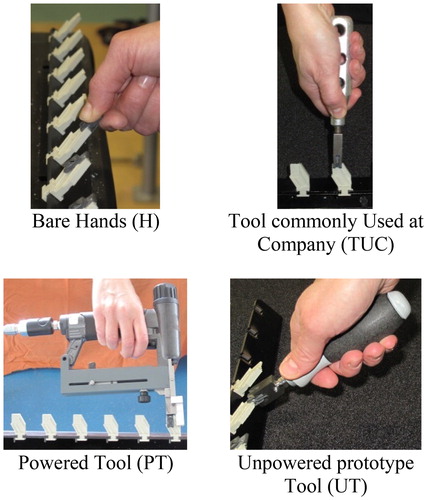1. Introduction
Estimating the physical exertion required to perform a work task and its physiological consequences is essential in the occupational environment. Its assessment can be performed using different subjective or objective, global or local, methods that are simple or more complex to use. The aim of this study is to compare three methods (effort self-assessment, resultant external force and muscular activities) for a simulated clip fitting activity performed in four different ways. This task is frequently encountered in automotive assembly processes, where it is often performed by female operators and commonly causes upper limb musculo-skeletal disorders (Gaudez Citation2008). The objective is to determine whether any one of these four ways generated lower physical exertion than the other ones.
2. Methods
Ten right-handed women, not suffering from musculoskeletal pain, fitted clips to supports in four different ways: with the bare Hand (H), with an unpowered Tool commonly Used at Company (TUC), with an Unpowered prototype Tool (UT) and with a Powered Tool (PT) (). The women's upper limbs were mobilised differently depending on the fitting method implemented. The three tools differed in handle shape and weight (TUC = 200 g, UT = 130 g, PT = 970 g). Each woman fitted eight clips into supports in each of the four ways. Each woman assessed the effort she exerted when fitting the clips, for each way she had just fulfilled, using an analogue visual scale of 10 cm long: zero cm corresponded to no effort and 10 cm to maximum effort. The 90th percentile for the resultant external force was measured using a force platform located under the supports. Surface electromyography was used to record the activity of flexor digitorum superficialis (FDS), extensor digitorum communis (EDC) and trapezius pars descendens (TRA) muscles in both limbs. These activities were expressed as a percentage of the maximum voluntary contraction (MVC) measured for each subject. The 10th, 50th and 90th percentiles were calculated for each muscular activity. The data were then analysed based on a 2-way mixed-effects ANOVA.
3. Results
The women stated that the effort was greater, when fitting with the bare hand than with the three tools (). Moreover, the resultant external force was greater, when fitting using the bare Hand than with the three tools. Clip fitting with the powered tool induced higher activities of right limb FDS, EDC and TRA muscles than the three other ways. Clip fitting with the bare hand induced higher activities of the right limb EDC muscle than when fitting with the two unpowered tools. The 90th percentile for FDS of the right limb was higher, when fitting with the tool commonly used at company than with the unpowered prototype tool. Clip fitting with the two unpowered tools, tool commonly used at company and unpowered prototype tool, induced higher activities of the left limb FDS and EDC muscles than fitting with the bare hand and the powered tool.
Table 1. Mean (standard deviation) and difference between two fitting ways, when ANOVA test is significant (p < 0.05), for effort self-assessment (cm), resultant external force (N) and muscular activities (percentage of the maximum voluntary contraction).
4. Discussion
The effort self-assessment and resultant external force methods gave similar results: fitting clips with the bare hand requires more exertion than the other three ways. However, these two methods convey different information. Effort self-assessment is a global, subjective method that refers to the overall state of perception felt by the participant. Among other things, it considers all the forces exerted by the body in relation to the person's physical condition, past experience, emotional state and environment. Resultant external force is an objective measurement. It quantifies the force applied to insert the clip into the support. It does not consider the force applied to grip the clip or the tool, the force required to hold the tool or the force exerted by the whole body. Unlike these two methods, the muscular activity method is an indicator of local physical load. It quantifies the effort exerted by the recorded muscle and, to some extent, the participant's psychological stress. The results provided by this method differ from those provided by the other two methods. The muscular activity method reveals the exertion differences between the two limbs depending on the way of fitting the clips. The right limb is more exerted, when using the powered tool or the bare hand, while the left limb is more exerted, when using the two unpowered tools. These muscular activity-based results therefore reveal that no single way of fitting clips induced a lower overall exertion than the other three ways. Alternating between the unpowered tools and the powered tool should therefore be considered in relation to performing the clip fitting task.
5. Conclusion
This study reveals that the use of a single method of assessing the physical exertion required to perform a work task may only provide fragmentary results, potentially leading to erroneous conclusions.
Disclosure statement
No potential conflict of interest was reported by the author(s).
Reference
- Gaudez C. 2008. Upper limb musculo-skeletal disorders and insert fitting activity in automobile sector: impact on muscular stresses of fitting method and insert position on part. Comput Methods Biomech Biomed Engin. 11(sup001):101–102.

